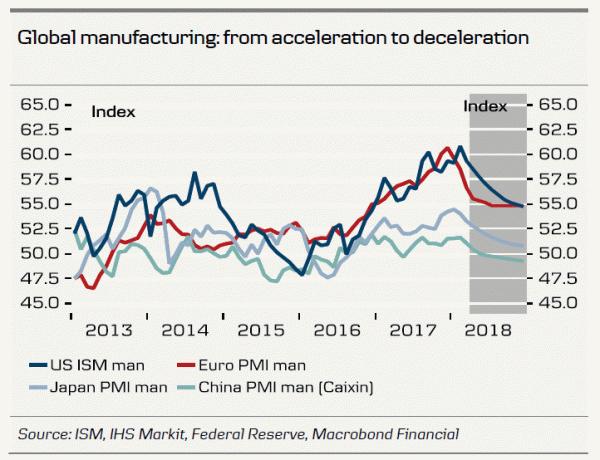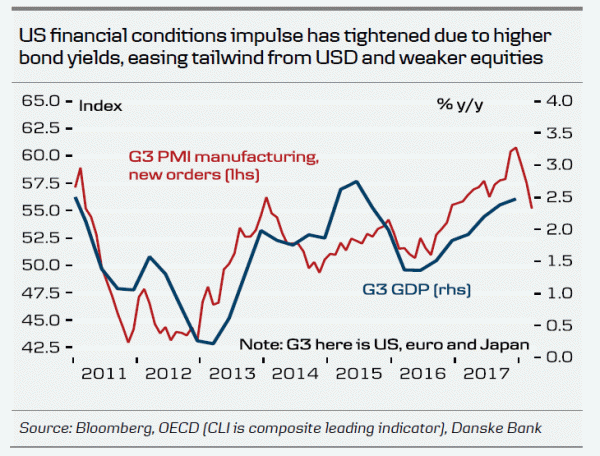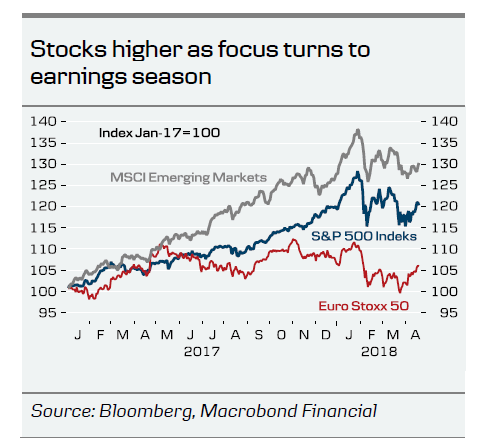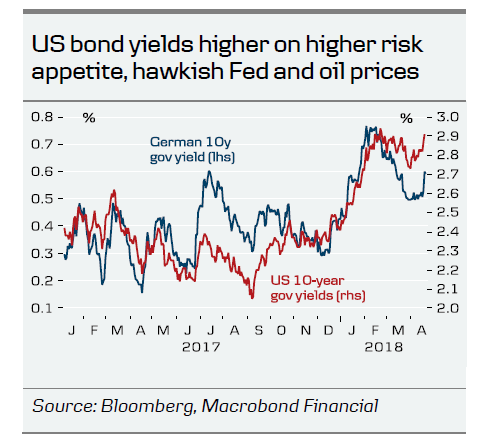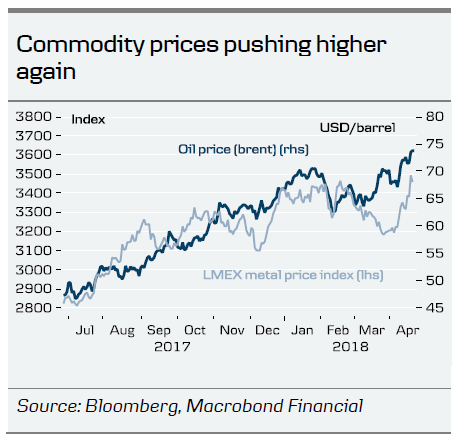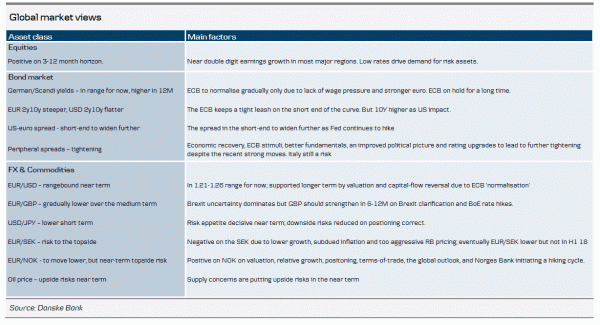Global business cycle weakening
We see clear signs that the global business cycle has peaked in early 2018 in line with our expectations outlined in Five Macro Themes for 2018, 3 January 2018. Our MacroScope models point to a further deceleration over the coming quarters. The recent uncertainty over a potential trade war is likely to reinforce this picture. Monetary tightening, higher yields, lower real wage growth, more uncertainty – and in the case of the euro area a stronger currency – are all factors pushing production growth a notch lower for the rest of 2018, in our view, 19 April 2018.
While the cycle is softening, we still expect growth levels to stay above potential growth in 2018 and 2019. US fiscal easing will temper any deceleration in 2019. Nevertheless, declining PMI levels across regions tends to cause some anxiety about the strength of the recovery, giving less support to risk assets and putting a cap on bond yields.
Trade tensions continue
The trade spat between the US and China has changed arena the past week as another battle is being fought in the tech area. On Monday, the US banned US sales to the Chinese telecommunications equipment maker ZTE for seven years, saying it had broken a settlement agreement. ZTE is one of the leading tech companies in China within telecoms equipment and gets 15% of its supplies from US companies. The move from the US could quickly backfire though. China has not yet approved a takeover deal by the big US tech company Qualcomm of Dutch semiconductor company NXP. China is going through an antitrust review and said this week it had found issues hard to resolve regarding the deal. An equally big problem for US tech companies could be that Chinese consumers are now posting patriotic statements on social media in China and continued obstacles for Chinese companies in the US would risk triggering a form of consumer boycott in China, see Reuters.
We are still awaiting whether Trump will go on and put tariffs on another USD100bn worth of Chinese imports. On 5 April, he instructed his Trade Representative Robert Lighthizer to look into this. If indeed Trump takes this step, China would likely retaliate immediately, leading to another escalation, see Flash Comment: Is Trump preparing for a round of trade escalation – again?, 13 April. We do not know exactly when Trump will reveal this but reports last week said it could come this week, see WSJ (paywall).
On a more positive note, China is not only using the ‘stick’ to fight back but also a ‘carrot’ by speeding up the opening up of the economy. Among measures announced are lower tariffs on cars and other products and removing the ownership cap within the car industry already this year for companies like Tesla, making Electric Vehicle cars, and a general removal for all passenger cars by 2022.
Our baseline scenario is still that we avoid a full-blown trade war, although we see a risk that it could get worse before it gets better if Trump goes through with announcing tariffs on another round of Chinese imports worth USD100bn.
We change our ECB call c0150 rate hike postponed
Today, we changed our ECB forecast and now expect a first hike of 20bp in December 2019 after Mario Draghi’s reign is over. We previously looked for a 10bp hike in June 2019, 20 April 2018. The reason we have pushed out the first hike is increased downside risks to growth and inflation and we believe the ECB will revise down its growth forecast in its next staff projection in June.
Risk sentiment rebound – commodity prices higher
Over the past week, we have seen a rebound in equity markets and bond yields as fears over a trade war have receded and the earnings season has put focus back on robust profit growth in the corporate sector. We continue to look for equities to outperform bonds over the next year, as earnings growth is expected to stay solid despite some softening in the global business cycle.
US bond yields saw some upward pressure from quite hawkish Fed comments, with several members suggesting that rates could move above the long-term neutral rate in the current hiking cycle. It pushed the two-year yield to the highest level in 10 years above 2.4%. Higher oil prices and a turn in risk appetite added to the increase in yields. In China, the People’s Bank of China made a small easing by cutting the Reserve Requirement Ratio from 17% to 16%. The liquidity injection will partly be compensated by liquidity being withdrawn in the Medium Lending Facility, but nevertheless the move led to a big decline in Chinese money market rates and bond yields.
In the commodity market, oil prices and metal prices have pushed higher, due mainly to a change in expectations regarding supply. Sanctions on Russia will reduce supply in, for example, aluminium, and uncertainty about Iran’s oil production could be reduced if Trump reinstates sanctions on Iran. We see upside risks to oil prices in the coming weeks. 12 May will be a key date to watch, as the EU has to decide on whether to support new sanctions on Iran. We continue to look for EUR/USD to be range bound in the near term before breaking higher towards 1.28 in 12M. 17 April 2018.




